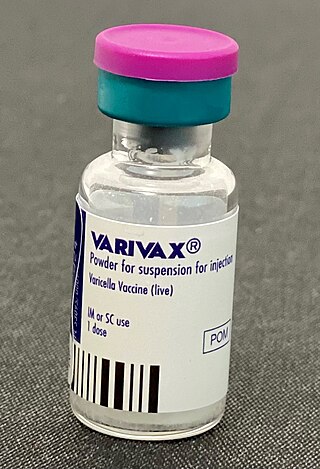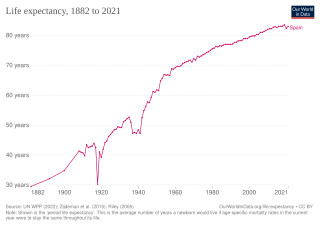
Preventive healthcare, or prophylaxis, consists of measures taken for the purposes of disease prevention. Disease and disability are affected by environmental factors, genetic predisposition, disease agents, and lifestyle choices, and are dynamic processes which begin before individuals realize they are affected. Disease prevention relies on anticipatory actions that can be categorized as primal, primary, secondary, and tertiary prevention.

A vaccination schedule is a series of vaccinations, including the timing of all doses, which may be either recommended or compulsory, depending on the country of residence. A vaccine is an antigenic preparation used to produce active immunity to a disease, in order to prevent or reduce the effects of infection by any natural or "wild" pathogen.

Meningococcal disease describes infections caused by the bacterium Neisseria meningitidis. It has a high mortality rate if untreated but is vaccine-preventable. While best known as a cause of meningitis, it can also result in sepsis, which is an even more damaging and dangerous condition. Meningitis and meningococcemia are major causes of illness, death, and disability in both developed and under-developed countries.
The Advisory Committee on Immunization Practices (ACIP) is a committee within the United States Centers for Disease Control and Prevention (CDC) that provides advice and guidance on effective control of vaccine-preventable diseases in the U.S. civilian population. The ACIP develops written recommendations for routine administration of vaccines to the pediatric and adult populations, along with vaccination schedules regarding appropriate timing, dosage, and contraindications of vaccines. ACIP statements are official federal recommendations for the use of vaccines and immune globulins in the U.S., and are published by the CDC.

Varicella vaccine, also known as chickenpox vaccine, is a vaccine that protects against chickenpox. One dose of vaccine prevents 95% of moderate disease and 100% of severe disease. Two doses of vaccine are more effective than one. If given to those who are not immune within five days of exposure to chickenpox it prevents most cases of disease. Vaccinating a large portion of the population also protects those who are not vaccinated. It is given by injection just under the skin. Another vaccine, known as zoster vaccine, is used to prevent diseases caused by the same virus – the varicella zoster virus.

Hepatitis B vaccine is a vaccine that prevents hepatitis B. The first dose is recommended within 24 hours of birth with either two or three more doses given after that. This includes those with poor immune function such as from HIV/AIDS and those born premature. It is also recommended that health-care workers be vaccinated. In healthy people routine immunization results in more than 95% of people being protected.
A vaccination policy is a health policy adopted in order to prevent the spread of infectious disease. These policies are generally put into place by State or local governments, but may also be set by private facilities, such as workplaces or schools. Many policies have been developed and implemented since vaccines were first made widely available.
Rotavirus vaccine is a vaccine used to protect against rotavirus infections, which are the leading cause of severe diarrhea among young children. The vaccines prevent 15–34% of severe diarrhea in the developing world and 37–96% of severe the risk of death among young children due to diarrhea. Immunizing babies decreases rates of disease among older people and those who have not been immunized.

Health in the United States is the overall health of the population of the United States. Health may refer to "a state of complete physical, mental and social well-being and not merely the absence of disease and infirmity.", according to the World Health Organization (WHO). 78.7 was the average life expectancy for individuals at birth in 2017. The highest cause of death for United States citizens is heart disease. Infectious diseases such as sexually transmitted diseases impact the health of approximately 19 million yearly. The two most commonly reported infectious diseases include chlamydia and gonorrhea. The United States is currently challenged by the COVID-19 pandemic, and is 19th in the world in COVID-19 vaccination rates. All 50 states in the U.S. require immunizations for children in order to enroll in public school, but various exemptions are available by state. Immunizations are often compulsory for military enlistment in the United States.

The major causes of deaths in Finland are cardiovascular diseases, malignant tumors, dementia and Alzheimer's disease, respiratory diseases, alcohol related diseases and accidental poisoning by alcohol. In 2010 the leading causes of death among men aged 15 to 64 were alcohol related deaths, ischaemic heart disease, accident, suicides, lung cancer and cerbrovascular diseases. Among women the leading causes were breast cancer, alcohol related deaths, accidents, suicides, ischaemic heart disease and lung cancer.

Italy is known for its generally very good health system, and the life expectancy is 80 for males and 85 for females, placing the country 5th in the world for life expectancy, and low infant mortality. In comparison to other Western countries, Italy has a relatively low rate of adult obesity, as there are several health benefits of the Mediterranean diet. The proportion of daily smokers was 22% in 2012, down from 24.4% in 2000 but still slightly above the OECD average. Smoking in public places including bars, restaurants, night clubs and offices has been restricted to specially ventilated rooms since 2005.

In 2012, life expectancy at birth in Spain reached 82.5 years, one of the highest among OECD countries and more than two years higher than the OECD average. Only Japan, Iceland and Switzerland had a higher life expectancy than Spain in 2012. The top three causes of death since 1970 have been cardiovascular diseases, cancer and respiratory diseases.

The Vaccines for Children Program (VFC) is a federally funded program in the United States providing no-cost vaccines to children who lack health insurance or who otherwise cannot afford the cost of the vaccination. The VFC program was created by the Omnibus Budget Reconciliation Act of 1993 and is required to be a new entitlement of each state's Medicaid plan under section 1928 of the Social Security Act. The program was officially implemented in October 1994 and serves eligible children in all U.S. states, as well as the Commonwealth of Puerto Rico, the U.S. Virgin Islands, American Samoa, Guam, and the Commonwealth of the Northern Mariana Islands.

Average life expectancy in France at birth was 81 years in 2008. A new measure of expected human capital calculated for 195 countries from 1990 to 2016 and defined for each birth cohort as the expected years lived from age 20 to 64 years and adjusted for educational attainment, learning or education quality, and functional health status was published by the Lancet in September 2018. France had the ninth highest level of expected human capital with 25 health, education, and learning-adjusted expected years lived between age 20 and 64 years.
Montenegro is a country with an area of 13,812 square kilometres and a population of 620,029, according to the 2011 census. The country is bordered by Croatia, the Adriatic Sea, Bosnia, Herzegovina, Serbia, Kosovo and Albania. The most common health issues faced are non-communicable diseases accounting for 95% of all deaths. This is followed by 4% of mortality due to injury, and 1% due to communicable, maternal, perinatal and nutritional conditions. Other health areas of interest are alcohol consumption, which is the most prevalent disease of addiction within Montenegro and smoking. Montenegro has one of the highest tobacco usage rates across Europe. Life expectancy for men is 74 years, and life expectancy for women is 79.
National Immunization Technical Advisory Group (NITAG) is an advisory committee consisting of multidisciplinary groups of experts responsible for providing information to national governments that is used to make evidence-based decisions regarding vaccine and immunization policy. The majority of industrialized and some developing countries have formally established advisory committees to guide immunization policies; other countries are working towards establishment of such committees.
The Standing Committee on Vaccination at the Robert Koch Institute, or STIKO, is a scientific committee comprising 18 members at the Robert Koch Institute in Berlin, Germany that provides official recommendations for the vaccination schedules used by the individual German states. The committee meets twice yearly to review the latest research regarding vaccination against infectious diseases. Although the STIKO makes recommendations, immunization in Germany is voluntary and there are no official government recommendations. German Federal States typically follow the STIKO's recommendations minimally, although each state can make recommendations for their geographic jurisdiction that extends beyond the recommended list. In addition to the proposed immunization schedule for children and adults, the STIKO recommends vaccinations for occupational groups, police, travelers, and other at risk groups.

Vaccination policy in the United States is the subset of U.S. health policy that deals with immunization against infectious disease. It is decided at various levels of the government, including the individual states. This policy has been developed over the approximately two centuries since the invention of vaccination with the purpose of eradicating disease from the U.S. population, or creating a herd immunity. Policies intended to encourage vaccination impact numerous areas of law, including regulation of vaccine safety, funding of vaccination programs, vaccine mandates, adverse event reporting requirements, and compensation for injuries asserted to be associated with vaccination.

The COVID-19 vaccination campaign in Germany began on 26 December 2020. As of 16 December 2021, 60,679,186 people have received at least one dose, while 58,174,724 people have been fully vaccinated.
The 2022 monkeypox outbreak in Germany is part of an ongoing global outbreak of human monkeypox caused by the West African clade of the monkeypox virus. At the beginning of September 2022, Spain, France, Germany and the United Kingdom are the countries with most cumulative cases in Europe.













